Vineyard Microclimatic Zoning as a Tool to Promote Sustainable Viticulture under Climate Change
Abstract
1. Introduction
2. Materials and Methods
2.1. Study Area Characterisation
2.2. Microclimate Model
2.3. Climate Data
2.4. Quantile Mapping
2.5. Agroclimatic Zoning
2.5.1. Growing Season Length
2.5.2. Extreme Summer Days
2.5.3. Tropical Nights
2.5.4. Huglin Heliothermic Index
2.5.5. Hydrothermal Index of Branas, Bernon and Levandoux
2.5.6. Dryness Index
3. Results
3.1. Microclimatic Characteristics
3.2. Climatic Indices
3.3. Bioclimatic Indices
4. Discussion
4.1. Microclimate
4.2. Extreme Climatic Indices
4.2.1. Growing Season Length
4.2.2. Extreme Summer Days
4.2.3. Tropical Nights
4.2.4. Precipitation Indices
4.3. Bioclimatic Indices
4.4. Climate Change Scenarios
4.5. Advantages and Disadvantages of Microclimate Models
5. Conclusions
Supplementary Materials
Author Contributions
Funding
Institutional Review Board Statement
Informed Consent Statement
Data Availability Statement
Acknowledgments
Conflicts of Interest
References
- IPCC Climate Change 2022: Impacts, Adaptation and Vulnerability; Working Group II Contribution to the IPCC Sixth Assessment Report; IPCC: Geneva, Switzerland, 2022.
- Jones, G.V.; Edwards, E.J.; Bonada, M.; Sadras, V.O.; Krstic, M.P.; Herderich, M.J. Climate Change and Its Consequences for Viticulture, Chapter 17. In Managing Wine Quality (Second Edition); Reynolds, A.G., Ed.; Woodhead Publishing: Cambridge, UK, 2022; pp. 727–778. ISBN 978-0-08-102067-8. [Google Scholar]
- Kimani, B.K. Influence of Temperature Variations on Grapevine Phenology. Am. J. Agric. 2024, 6, 46–55. [Google Scholar]
- Fraga, H.; Malheiro, A.C.; Moutinho-Pereira, J.; Santos, J.A. An Overview of Climate Change Impacts on European Viticulture. Food Energy Secur. 2012, 1, 94–110. [Google Scholar] [CrossRef]
- Van Leeuwen, C.; Darriet, P. The Impact of Climate Change on Viticulture and Wine Quality. J. Wine Econ. 2016, 11, 150–167. [Google Scholar] [CrossRef]
- Moutinho-Pereira, J.M.; Correia, C.M.; Gonçalves, B.M.; Bacelar, E.A.; Torres-Pereira, J.M. Leaf Gas Exchange and Water Relations of Grapevines Grown in Three Different Conditions. Photosynthetica 2004, 42, 81–86. [Google Scholar] [CrossRef]
- Santos, J.A.; Fraga, H.; Malheiro, A.C.; Moutinho-Pereira, J.; Dinis, L.-T.; Correia, C.; Moriondo, M.; Leolini, L.; Dibari, C.; Costafreda-Aumedes, S. A Review of the Potential Climate Change Impacts and Adaptation Options for European Viticulture. Appl. Sci. 2020, 10, 3092. [Google Scholar] [CrossRef]
- Poni, S.; Sabbatini, P.; Palliotti, A. Facing Spring Frost Damage in Grapevine: Recent Developments and the Role of Delayed Winter Pruning—A Review. Am. J. Enol. Vitic. 2022, 73, 211–226. [Google Scholar] [CrossRef]
- Kovács, L.G.; Byers, P.L.; Kaps, M.L.; Saenz, J. Dormancy, Cold Hardiness, and Spring Frost Hazard in Vitis Amurensis Hybrids under Continental Climatic Conditions. Am. J. Enol. Vitic. 2003, 54, 8–14. [Google Scholar] [CrossRef]
- Costa, J.M.; Egipto, R.; Aguiar, F.C.; Marques, P.; Nogales, A.; Madeira, M. The Role of Soil Temperature in Mediterranean Vineyards in a Climate Change Context. Front. Plant Sci. 2023, 14, 1145137. [Google Scholar] [CrossRef]
- Giffard, B.; Winter, S.; Guidoni, S.; Nicolai, A.; Castaldini, M.; Cluzeau, D.; Coll, P.; Cortet, J.; Le Cadre, E.; D’errico, G. Vineyard Management and Its Impacts on Soil Biodiversity, Functions, and Ecosystem Services. Front. Ecol. Evol. 2022, 10, 850272. [Google Scholar] [CrossRef]
- Andrés, P.; Doblas-Miranda, E.; Silva-Sánchez, A.; Mattana, S.; Font, F. Physical, Chemical, and Biological Indicators of Soil Quality in Mediterranean Vineyards under Contrasting Farming Schemes. Agronomy 2022, 12, 2643. [Google Scholar] [CrossRef]
- Viers, J.H.; Williams, J.N.; Nicholas, K.A.; Barbosa, O.; Kotzé, I.; Spence, L.; Webb, L.B.; Merenlender, A.; Reynolds, M. Vinecology: Pairing Wine with Nature. Conserv. Lett. 2013, 6, 287–299. [Google Scholar] [CrossRef]
- Maltman, A. The Role of Vineyard Geology in Wine Typicity. J. Wine Res. 2008, 19, 1–17. [Google Scholar] [CrossRef]
- Lisso, L.; Lindsay, J.B.; Berg, A. Evaluating the Topographic Factors for Land Suitability Mapping of Specialty Crops in Southern Ontario. Agronomy 2024, 14, 319. [Google Scholar] [CrossRef]
- Van Leeuwen, C. Terroir: The Effect of the Physical Environment on Vine Growth, Grape Ripening, and Wine Sensory Attributes. In Managing Wine Quality; Elsevier: Amsterdam, The Netherlands, 2022; pp. 341–393. [Google Scholar]
- Karapetsas, N.; Alexandridis, T.K.; Bilas, G.; Theocharis, S.; Koundouras, S. Delineating Natural Terroir Units in Wine Regions Using Geoinformatics. Agriculture 2023, 13, 629. [Google Scholar] [CrossRef]
- Matese, A.; Crisci, A.; Di Gennaro, S.F.; Primicerio, J.; Tomasi, D.; Marcuzzo, P.; Guidoni, S. Spatial Variability of Meteorological Conditions at Different Scales in Viticulture. Agric. For. Meteorol. 2014, 189, 159–167. [Google Scholar] [CrossRef]
- Iliff, C.J. The Influence of Climate Change and State Regulatory Systems on Independent Wine Production. Master’s Thesis, Texas State University, San Marcos, TX, USA, 2020. [Google Scholar]
- Pretorius, I.S. Tasting the Terroir of Wine Yeast Innovation. FEMS Yeast Res. 2020, 20, foz084. [Google Scholar] [CrossRef] [PubMed]
- Biss, A.J. Impact of Vineyard Topography on the Quality of Chablis Wine. Aust. J. Grape Wine Res. 2020, 26, 247–258. [Google Scholar] [CrossRef]
- Jones, G.V.; White, M.A.; Cooper, O.R.; Storchmann, K. Climate Change and Global Wine Quality. Clim. Change 2005, 73, 319–343. [Google Scholar] [CrossRef]
- Neethling, E.; Petitjean, T.; Quénol, H.; Barbeau, G. Assessing Local Climate Vulnerability and Winegrowers’ Adaptive Processes in the Context of Climate Change. Mitig. Adapt. Strateg. Glob. Change 2017, 22, 777–803. [Google Scholar] [CrossRef]
- Fonseca, A.; Santos, J.; Pádua, L.; Santos, M. Unveiling the Future of Relict Mediterranean Mountain Peatlands by Integrating the Potential Response of Ecological Indicators with Environmental Suitability Assessments. Ecol. Indic. 2023, 157, 111206. [Google Scholar] [CrossRef]
- Le Cap, C.; Carlier, J.; Quénol, H.; Heitz, D.; Buisson, E. Analysis of the Spatial Variability of Temperature with the Aim of Improving the Location of Wind Machines. Theor. Appl. Clim. Climatol. 2024, 155, 421–438. [Google Scholar] [CrossRef]
- Tang, T.; Radomski, M.; Stefan, M.; Perrelli, M.; Fan, H. UAV-Based High Spatial and Temporal Resolution Monitoring and Mapping of Surface Moisture Status in a Vineyard. Pap. Appl. Geogr. 2020, 6, 402–415. [Google Scholar] [CrossRef]
- Noirault, A.; Achtziger, R.; Richert, E.; Goldberg, V.; Köstner, B. Modelling the Microclimate of a Saxonian Terraced Vineyard with ENVI-Met. Freib. Ecol. Online 2020, 7, 21–41. [Google Scholar]
- Schmidt, D.; Bahr, C.; Friedel, M.; Kahlen, K. Modelling Approach for Predicting the Impact of Changing Temperature Conditions on Grapevine Canopy Architectures. Agronomy 2019, 9, 426. [Google Scholar] [CrossRef]
- Quénol, H.; Neethling, E.; Barbeau, G.; Tissot, C.; Rouan, M.; Le Coq, C.; Le Roux, R. Adapting Viticulture to Climate Change Guidance Manual to Support Winegrowers’ Decision-Making. Ph.D. Thesis, CNRS LETG, University of Rennes, Rennes, France, 2020. [Google Scholar]
- Alexopoulos, A.; Koutras, K.; Ali, S.B.; Puccio, S.; Carella, A.; Ottaviano, R.; Kalogeras, A. Complementary Use of Ground-Based Proximal Sensing and Airborne/Spaceborne Remote Sensing Techniques in Precision Agriculture: A Systematic Review. Agronomy 2023, 13, 1942. [Google Scholar] [CrossRef]
- Karunathilake, E.; Le, A.T.; Heo, S.; Chung, Y.S.; Mansoor, S. The Path to Smart Farming: Innovations and Opportunities in Precision Agriculture. Agriculture 2023, 13, 1593. [Google Scholar] [CrossRef]
- Bayomi, N.; Fernandez, J.E. Eyes in the Sky: Drones Applications in the Built Environment under Climate Change Challenges. Drones 2023, 7, 637. [Google Scholar] [CrossRef]
- Alexandris, S.; Psomiadis, E.; Proutsos, N.; Philippopoulos, P.; Charalampopoulos, I.; Kakaletris, G.; Papoutsi, E.-M.; Vassilakis, S.; Paraskevopoulos, A. Integrating Drone Technology into an Innovative Agrometeorological Methodology for the Precise and Real-Time Estimation of Crop Water Requirements. Hydrology 2021, 8, 131. [Google Scholar] [CrossRef]
- Kearney, M.R.; Porter, W.P. NicheMapR–an R Package for Biophysical Modelling: The Microclimate Model. Ecography 2017, 40, 664–674. [Google Scholar] [CrossRef]
- Kearney, M.R.; Gillingham, P.K.; Bramer, I.; Duffy, J.P.; Maclean, I.M.D. A Method for Computing Hourly, Historical, Terrain-Corrected Microclimate Anywhere on Earth. Methods Ecol. Evol. 2020, 11, 38–43. [Google Scholar] [CrossRef]
- Kearney, M.R.; Briscoe, N.J.; Mathewson, P.D.; Porter, W.P. NicheMapR–an R Package for Biophysical Modelling: The Endotherm Model. Ecography 2021, 44, 1595–1605. [Google Scholar] [CrossRef]
- Kearney, M. Introduction to the NicheMapR Ectotherm Model. 2022. Available online: https://mrke.github.io/NicheMapR/inst/doc/ectotherm-model-tutorial.html (accessed on 1 September 2023).
- Kearney, M.R.; Porter, W.P. NicheMapR–an R Package for Biophysical Modelling: The Ectotherm and Dynamic Energy Budget Models. Ecography 2020, 43, 85–96. [Google Scholar] [CrossRef]
- Klinges, D.H.; Duffy, J.P.; Kearney, M.R.; Maclean, I.M.D. Mcera5: Driving Microclimate Models with ERA5 Global Gridded Climate Data. Methods Ecol. Evol. 2022, 13, 1402–1411. [Google Scholar] [CrossRef]
- Muñoz-Sabater, J.; Dutra, E.; Agustí-Panareda, A.; Albergel, C.; Arduini, G.; Balsamo, G.; Boussetta, S.; Choulga, M.; Harrigan, S.; Hersbach, H. ERA5-Land: A State-of-the-Art Global Reanalysis Dataset for Land Applications. Earth Syst. Sci. Data 2021, 13, 4349–4383. [Google Scholar] [CrossRef]
- Hufkens, K.; Stauffer, R.; Campitelli, E. The Ecwmfr Package: An Interface to ECMWF API Endpoints. Zenodo 2019. [Google Scholar] [CrossRef]
- Spinu, V.; Grolemund, G.; Wickham, H.; Lyttle, I.; Constigan, I.; Law, J.; Mitarotonda, D.; Larmarange, J.; Boiser, J.; Lee, C.H. Lubridate: Make Dealing with Dates a Little Easier (1.9.3); 2023. Available online: https://cran.r-project.org/web/packages/lubridate/lubridate.pdf (accessed on 1 October 2023).
- Wickham, H.; François, R.; Henry, L.; Müller, K. Dplyr: A Grammar of Data Manipulation 2018. Available online: https://cloud.r-project.org/web/packages/dplyr/index.html (accessed on 1 December 2023).
- Sumner, M. Tidync A Tidy Approach to ‘NetCDF’ Data Exploration and Extraction 2022. Available online: https://cran.r-project.org/web/packages/tidync/index.html (accessed on 1 November 2023).
- Rew, R.; Davis, G. NetCDF: An Interface for Scientific Data Access. IEEE Comput. Graph. Appl. 1990, 10, 76–82. [Google Scholar] [CrossRef]
- Hollister, J.; Shah, T.; Robitaille, A.; Beck, M.; Johnson, M. Elevatr: Access Elevation Data from Various APIs; R Package Version 0.1; U.S. EPA Office of Research and Development: Washington, DC, USA, 2017. [Google Scholar]
- Porter, W.P.; Mitchell, J.W.; Beckman, W.A.; DeWitt, C.B. Behavioral Implications of Mechanistic Ecology. Oecologia 1973, 13, 1–54. [Google Scholar] [CrossRef]
- Enriquez-Urzelai, U.; Tingley, R.; Kearney, M.R.; Sacco, M.; Palacio, A.S.; Tejedo, M.; Nicieza, A.G. The Roles of Acclimation and Behaviour in Buffering Climate Change Impacts along Elevational Gradients. J. Anim. Ecol. 2020, 89, 1722–1734. [Google Scholar] [CrossRef] [PubMed]
- Kearney, M.R.; Simpson, S.J.; Raubenheimer, D.; Kooijman, S.A.L.M. Balancing Heat, Water and Nutrients under Environmental Change: A Thermodynamic Niche Framework. Funct. Ecol. 2013, 27, 950–966. [Google Scholar] [CrossRef]
- Ma, L.; Conradie, S.R.; Crawford, C.L.; Gardner, A.S.; Kearney, M.R.; Maclean, I.M.D.; McKechnie, A.E.; Mi, C.-R.; Senior, R.A.; Wilcove, D.S. Global Patterns of Climate Change Impacts on Desert Bird Communities. Nat. Commun. 2023, 14, 211. [Google Scholar] [CrossRef] [PubMed]
- Visintin, C.; Briscoe, N.; Kearney, M.; Ryan, G.; Nitschke, C.; Wintle, B. Mapping Distributions, Threats and Opportunities to Conserve the Greater Glider by Integrating Biophysical and Spatially-Explicit Population Models. 2021. Available online: https://www.nespthreatenedspecies.edu.au/media/zo3iv32y/4-4-8-greater-glider-modelling-report_v2.pdf (accessed on 1 February 2024).
- Gammon, M.; Bentley, B.; Fossette, S.; Mitchell, N. Reconstructing 32-Years of Sand Temperature to Characterise Thermal Exposure of Sea Turtle Eggs, and Risk from Climate Change. Characterising Climate Change Vulnerability at Flatback Turtle Nesting Sites in the Pilbara Region of Western Australia 118. Master’s Thesis, University of Western Australia, Perth, Australia, 2023. [Google Scholar]
- Mitchell, N.; Hipsey, M.R.; Arnall, S.; McGrath, G.; Tareque, H.B.; Kuchling, G.; Vogwill, R.; Sivapalan, M.; Porter, W.P.; Kearney, M.R. Linking Eco-Energetics and Eco-Hydrology to Select Sites for the Assisted Colonization of Australia’s Rarest Reptile. Biology 2012, 2, 1–25. [Google Scholar] [CrossRef] [PubMed]
- Caldwella, A.J.; Whilea, G.M.; Wapstraa, E.; Kearneyc, M.R. Towards a Mechanistic Framework for Interpreting Climatic Effects on Widespread and Highland Temperate Reptile Species. Can Snow Skinks Survive Climate Change? Ph.D Thesis, School of Biological Sciences, University of Tasmania, Hobart, Australia, 2016. [Google Scholar]
- Pincebourde, S.; Woods, H.A. There Is Plenty of Room at the Bottom: Microclimates Drive Insect Vulnerability to Climate Change. Curr. Opin. Insect Sci. 2020, 41, 63–70. [Google Scholar] [CrossRef] [PubMed]
- Carter, A.; Kearney, M.; Mitchell, N.; Hartley, S.; Porter, W.; Nelson, N. Modelling the Soil Microclimate: Does the Spatial or Temporal Resolution of Input Parameters Matter? Front. Biogeogr. 2015, 7. [Google Scholar] [CrossRef]
- Jacob, D.; Petersen, J.; Eggert, B.; Alias, A.; Christensen, O.B.; Bouwer, L.M.; Braun, A.; Colette, A.; Déqué, M.; Georgievski, G.; et al. EURO-CORDEX: New High-Resolution Climate Change Projections for European Impact Research. Reg. Environ. Change 2014, 14, 563–578. [Google Scholar] [CrossRef]
- Muñoz Sabater, J. ERA5-Land Hourly Data from 1950 to Present. Copernicus Climate Change Service (C3S); Climate Data Store (CDS), 2021; pp. 1181–1194. [Google Scholar] [CrossRef]
- Gudmundsson, L.; Bremnes, J.B.; Haugen, J.E.; Engen-Skaugen, T. Downscaling RCM Precipitation to the Station Scale Using Statistical Transformations–a Comparison of Methods. Hydrol. Earth Syst. Sci. 2012, 16, 3383–3390. [Google Scholar] [CrossRef]
- Schulzweida, U.; Kornblueh, L.; Quast, R. CDO User Guide. Max Planck Institute for Meteorology: Hamburg, Germany, 2019. [Google Scholar]
- Santos, M.; Fonseca, A.; Fraga, H.; Jones, G.V.; Santos, J.A. Bioclimatic Conditions of the Portuguese Wine Denominations of Origin under Changing Climates. Int. J. Climatol. 2020, 40, 927–941. [Google Scholar] [CrossRef]
- Huglin, M. Nouveau Mode d’évaluation Des Possibilités Héliothermiques d’un Milieu Viticole. Comptes Rendus Séances L’académie D’Agric. Fr. 1978, 64, 1117–1126. [Google Scholar]
- Branas, J.; Bernon, G.; Levadoux, L. Eléments de Viticulture Générale; École National d’Agriculture: Montpellier, France, 1946. [Google Scholar]
- Tonietto, J.; Carbonneau, A. A Multicriteria Climatic Classification System for Grape-Growing Regions Worldwide. Agric. Meteorol. 2004, 124, 81–97. [Google Scholar] [CrossRef]
- Riou, C. Le Determinisme Climatique de La Maturation Du Raisin. Application Au Zonage de La Teneur En Sucre Dans La Communaute Europeenne. Institut National de la Recherche Agronomique Bordeaux, France 1992. Available online: https://op.europa.eu/en/publication-detail/-/publication/3edc0da9-f95a-4d53-871a-594267de7956/language-fr (accessed on 1 February 2024).
- Pereyra, G.; Pellegrino, A.; Ferrer, M.; Gaudin, R. How Soil and Climate Variability within a Vineyard Can Affect the Heterogeneity of Grapevine Vigour and Production. OENO One 2023, 57, 297–313. [Google Scholar] [CrossRef]
- Jogaiah, S. Vineyard Management Strategies in Scenario of Climate Change—A Review. Grape Insight 2023, 1, 11–22. [Google Scholar] [CrossRef]
- Navrátilová, M.; Beranová, M.; Severová, L.; Šrédl, K.; Svoboda, R.; Abrhám, J. The Impact of Climate Change on the Sugar Content of Grapes and the Sustainability of Their Production in the Czech Republic. Sustainability 2020, 13, 222. [Google Scholar] [CrossRef]
- Sodini, M.; Callesen, T.; Canton, M.; Tezza, L.; Campos, F.B.; Zanotelli, D.; Tarolli, P.; Sivilotti, P.; Pitacco, A.; Tagliavini, M. Major Threats Caused by Climate Change to Grapevine. ITALUS HORTUS 2023, 30, 1–24. [Google Scholar] [CrossRef]
- Modina, D.; Cola, G.; Bianchi, D.; Bolognini, M.; Mancini, S.; Foianini, I.; Cappelletti, A.; Failla, O.; Brancadoro, L. Alpine Viticulture and Climate Change: Environmental Resources and Limitations for Grapevine Ripening in Valtellina, Italy. Plants 2023, 12, 2068. [Google Scholar] [CrossRef] [PubMed]
- Dinis, L.-T.; Bernardo, S.; Conde, A.; Pimentel, D.; Ferreira, H.; Félix, L.; Gerós, H.; Correia, C.M.; Moutinho-Pereira, J. Kaolin Exogenous Application Boosts Antioxidant Capacity and Phenolic Content in Berries and Leaves of Grapevine under Summer Stress. J. Plant Physiol. 2016, 191, 45–53. [Google Scholar] [CrossRef] [PubMed]
- Fraga, H.; Molitor, D.; Leolini, L.; Santos, J.A. What Is the Impact of Heatwaves on European Viticulture? A Modelling Assessment. Appl. Sci. 2020, 10, 3030. [Google Scholar] [CrossRef]
- Cabral, I.L.; Teixeira, A.; Ferrier, M.; Lanoue, A.; Valente, J.; Rogerson, F.S.; Alves, F.; Carvalho, S.M.P.; Gerós, H.V.; Queiroz, J. Canopy Management through Crop Forcing Impacts Grapevine Cv.‘Touriga Nacional’Performance, Ripening and Berry Metabolomics Profile. OENO One 2023, 57, 55–69. [Google Scholar] [CrossRef]
- Alvarez Arredondo, J.; Muñoz, J.; Casassa, L.F.; Dodson Peterson, J.C. The Effect of Supplemental Irrigation on a Dry-Farmed Vitis vinifera L. cv. Zinfandel Vineyard as a Function of Vine Age. Agronomy 2023, 13, 1998. [Google Scholar] [CrossRef]
- Sun, Q.; Granco, G.; Groves, L.; Voong, J.; Van Zyl, S. Viticultural Manipulation and New Technologies to Address Environmental Challenges Caused by Climate Change. Climate 2023, 11, 83. [Google Scholar] [CrossRef]
- Zarrouk, O.; Garcia-Tejero, I.; Pinto, C.; Genebra, T.; Sabir, F.; Prista, C.; David, T.S.; Loureiro-Dias, M.C.; Chave, M.M. Aquaporins Isoforms in Cv. Touriga Nacional Grapevine under Water Stress and Recovery—Regulation of Expression in Leaves and Roots. Agric. Water Manag. 2016, 164, 167–175. [Google Scholar] [CrossRef]
- Tombesi, S.; Cincera, I.; Frioni, T.; Ughini, V.; Gatti, M.; Palliotti, A.; Poni, S. Relationship among Night Temperature, Carbohydrate Translocation and Inhibition of Grapevine Leaf Photosynthesis. Environ. Exp. Bot. 2019, 157, 293–298. [Google Scholar] [CrossRef]
- Droulia, F.; Charalampopoulos, I. A Review on the Observed Climate Change in Europe and Its Impacts on Viticulture. Atmosphere 2022, 13, 837. [Google Scholar] [CrossRef]
- Van Leeuwen, C.; Barbe, J.-C.; Darriet, P.; Geffroy, O.; Gomès, E.; Guillaumie, S.; Helwi, P.; Laboyrie, J.; Lytra, G.; Le Menn, N. Recent Advancements in Understanding the Terroir Effect on Aromas in Grapes and Wines: This Article Is Published in Cooperation with the XIIIth International Terroir Congress November 17-18 2020, Adelaide, Australia. Guest Editors: Cassandra Collins and Roberta De Bei. OENO One 2020, 54, 985–1006. [Google Scholar]
- Sanderson, M.G.; Teixeira, M.; Fontes, N.; Silva, S.; Graça, A. The Probability of Unprecedented High Rainfall in Wine Regions of Northern Portugal. Clim. Serv. 2023, 30, 100363. [Google Scholar] [CrossRef]
- Pereira, L.S.; Paredes, P.; Oliveira, C.M.; Montoya, F.; López-Urrea, R.; Salman, M. Single and Basal Crop Coefficients for Estimation of Water Use of Tree and Vine Woody Crops with Consideration of Fraction of Ground Cover, Height, and Training System for Mediterranean and Warm Temperate Fruit and Leaf Crops. Irrig. Sci. 2023, 1–40. [Google Scholar] [CrossRef]
- Guion, A.; Turquety, S.; Polcher, J.; Pennel, R.; Bastin, S.; Arsouze, T. Droughts and Heatwaves in the Western Mediterranean: Impact on Vegetation and Wildfires Using the Coupled WRF-ORCHIDEE Regional Model (RegIPSL). Clim. Dyn. 2022, 58, 2881–2903. [Google Scholar] [CrossRef]
- Reis, S.; Fraga, H.; Carlos, C.; Silvestre, J.; Eiras-Dias, J.; Rodrigues, P.; Santos, J.A. Grapevine Phenology in Four Portuguese Wine Regions: Modeling and Predictions. Appl. Sci. 2020, 10, 3708. [Google Scholar] [CrossRef]
- Gambetta, G.A.; Kurtural, S.K. Global Warming and Wine Quality: Are We Close to the Tipping Point? OENO One 2021, 55, 353–361. [Google Scholar] [CrossRef]
- Fraga, H.; Guimarães, N.; Santos, J. Vintage Port Prediction and Climate Change Scenarios. OENO One 2023, 57. [Google Scholar] [CrossRef]
- Mirás-Avalos, J.M.; Trigo-Córdoba, E.; Bouzas-Cid, Y.; Orriols-Fernández, I. Irrigation Effects on the Performance of Grapevine (Vitis vinifera L.) Cv.‘Albariño’under the Humid Climate of Galicia. OENO One 2016, 50. [Google Scholar] [CrossRef]
- Fonseca, A.; Fraga, H.; Santos, J.A. Exposure of Portuguese Viticulture to Weather Extremes under Climate Change. Clim. Serv. 2023, 30, 100357. [Google Scholar] [CrossRef]
- Martins, J.; Fraga, H.; Fonseca, A.; Santos, J.A. Climate Projections for Precipitation and Temperature Indicators in the Douro Wine Region: The Importance of Bias Correction. Agronomy 2021, 11, 990. [Google Scholar] [CrossRef]
- Rouxinol, M.I.; Martins, M.R.; Barroso, J.M.; Rato, A.E. Wine Grapes Ripening: A Review on Climate Effect and Analytical Approach to Increase Wine Quality. Appl. Biosci. 2023, 2, 347–372. [Google Scholar] [CrossRef]
- Pavlidis, V.; Kartsios, S.; Karypidou, M.C.; Katragkou, E. Future Evolution of Agroclimatic Indicators over a Viticulture Area in Greece. Environ. Sci. Proc. 2023, 26, 151. [Google Scholar] [CrossRef]
- Massano, L.; Fosser, G.; Gaetani, M.; Bois, B. Assessment of Climate Impact on Grape Productivity: A New Application for Bioclimatic Indices in Italy. Sci. Total Environ. 2023, 905, 167134. [Google Scholar] [CrossRef] [PubMed]
- Bruse, M. ENVI-Met 3.0: Updated Model Overview. University of Bochum. 2004. Available online: www.envi-met.com (accessed on 1 February 2024).
- Bramer, I.; Anderson, B.J.; Bennie, J.; Bladon, A.J.; De Frenne, P.; Hemming, D.; Hill, R.A.; Kearney, M.R.; Körner, C.; Korstjens, A.H. Advances in Monitoring and Modelling Climate at Ecologically Relevant Scales. In Advances in Ecological Research; Elsevier: Amsterdam, The Netherlands, 2018; Volume 58, pp. 101–161. ISBN 0065-2504. [Google Scholar]
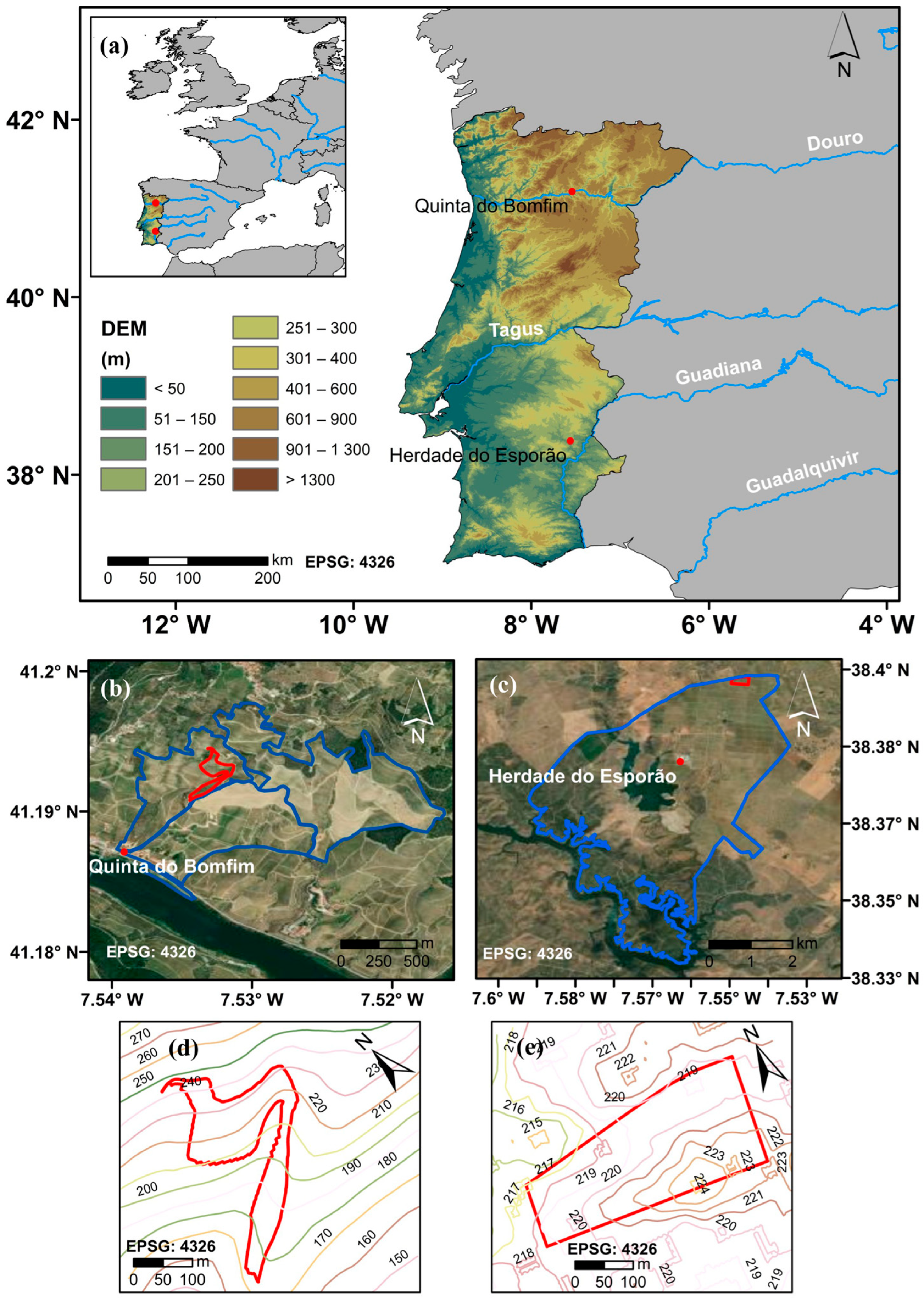
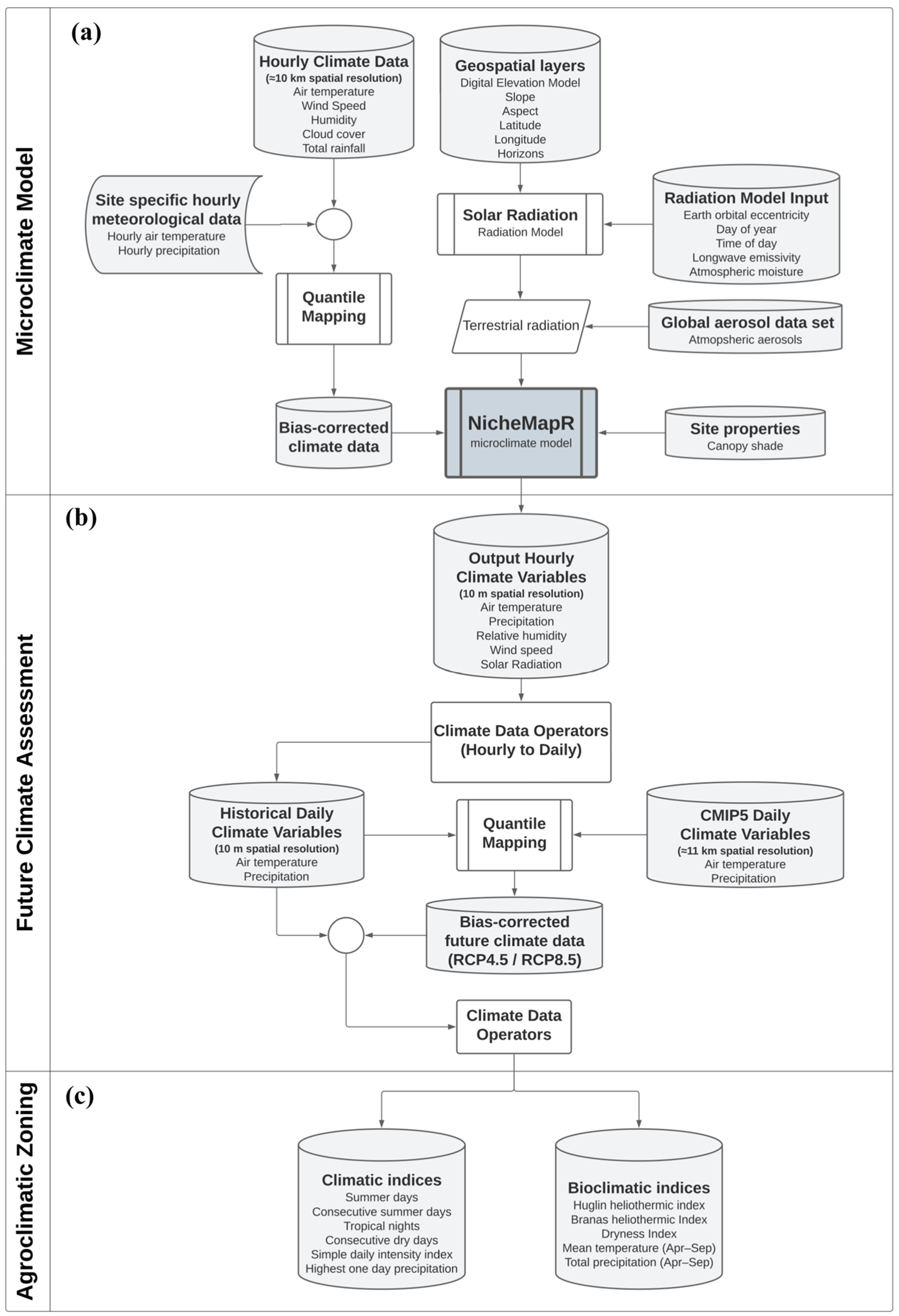
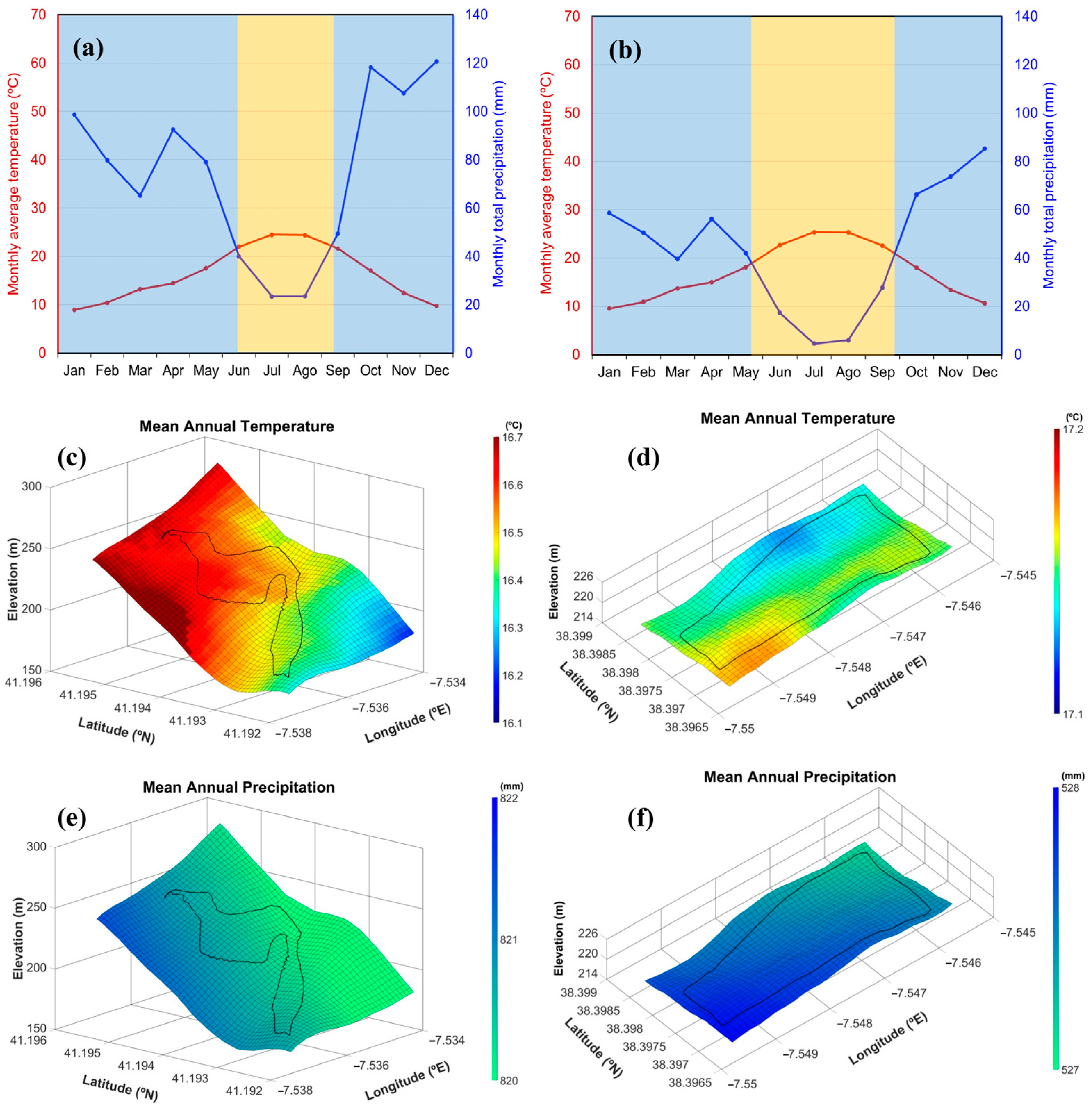


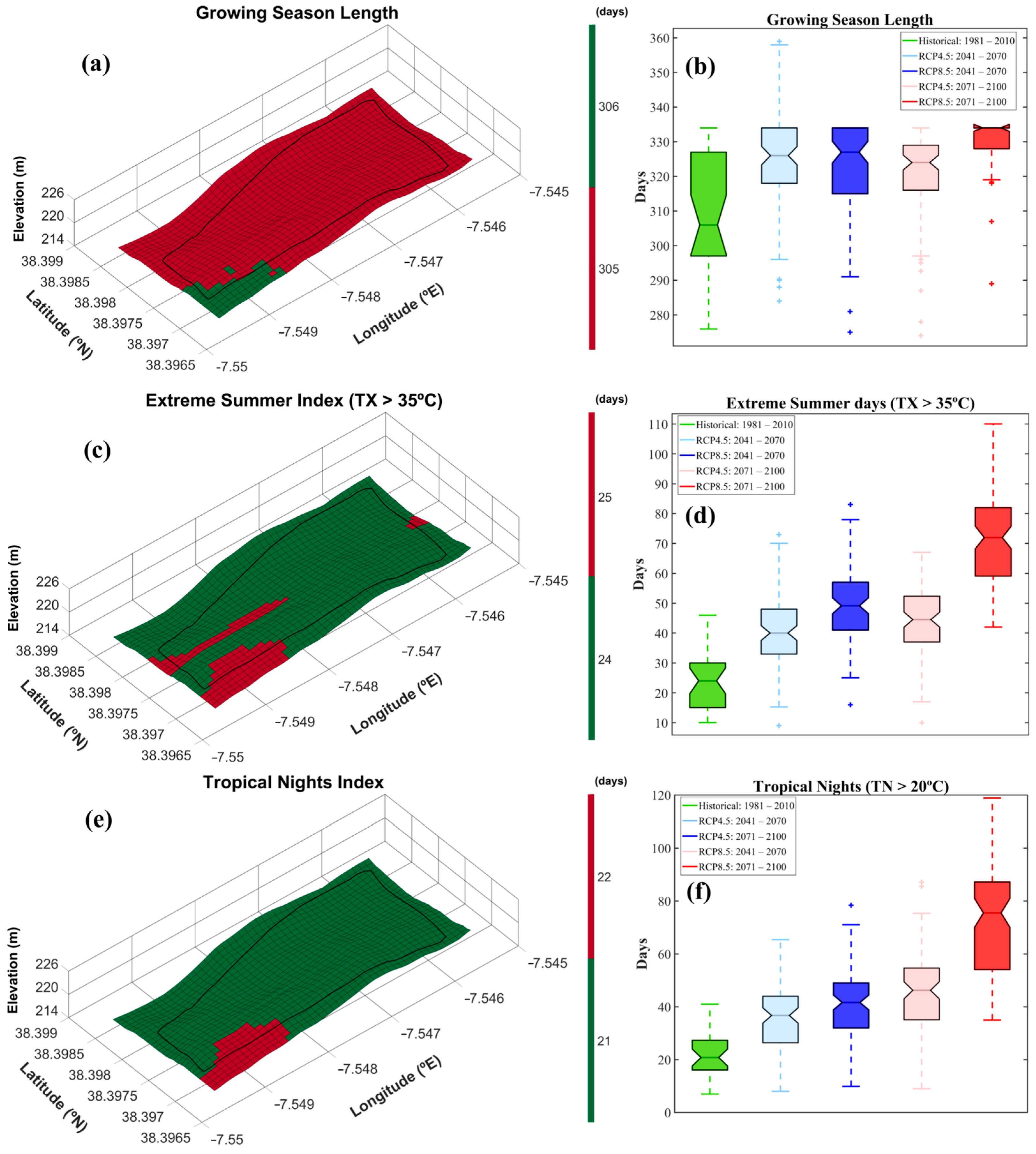
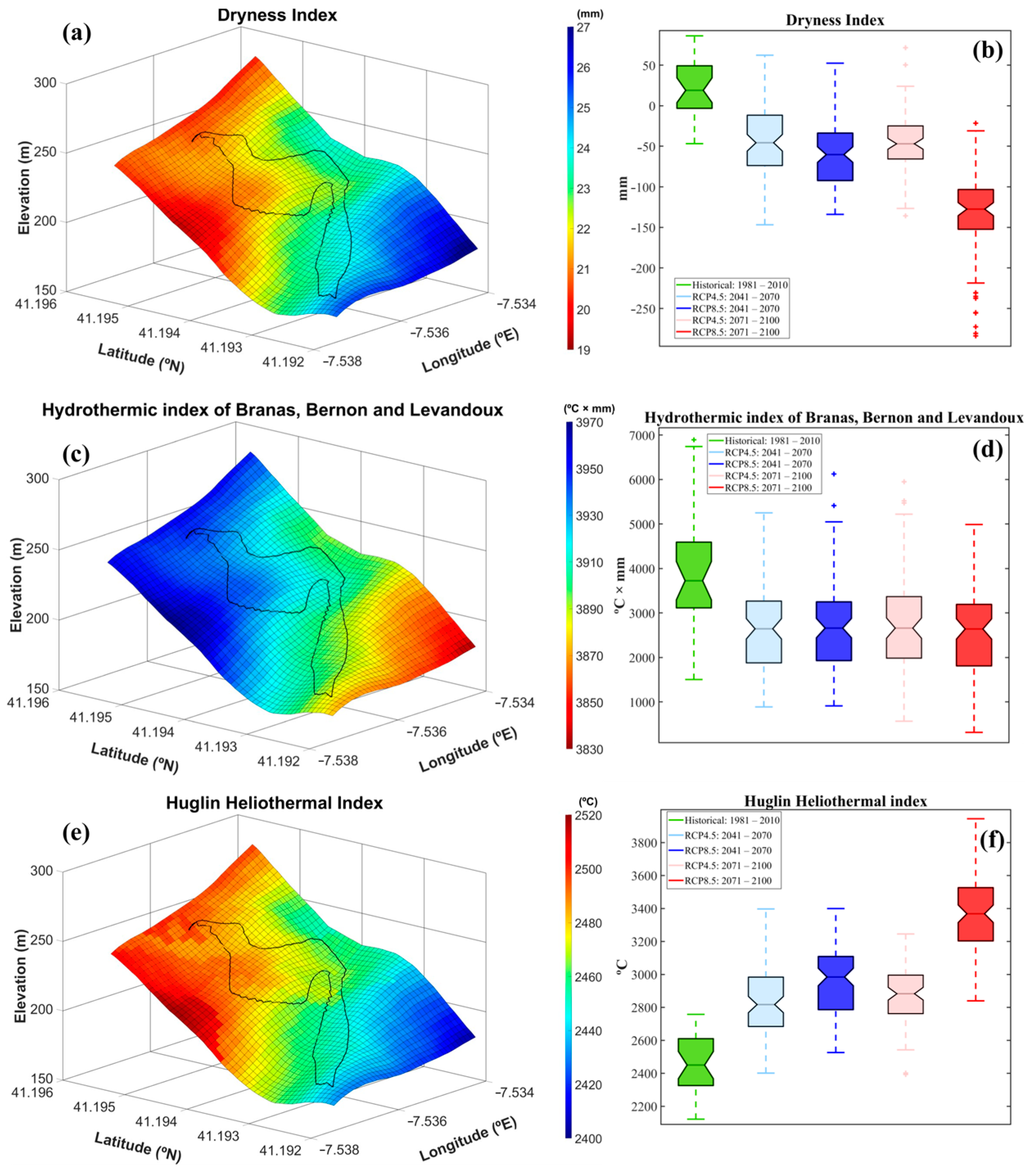

| Index | QB | HE | ||||
|---|---|---|---|---|---|---|
| Historical | RCP4.5 | RCP8.5 | Historical | RCP4.5 | RCP8.5 | |
| Precipitation (April–September) (mm) | 255 | 169 | 160 | 150 | 103 | 81 |
| Simple daily intensity index (mm) | 7 | 7 | 8 | 6 | 6 | 7 |
| Precipitation days above 20 mm (days) | 7 | 7 | 7 | 3 | 3 | 4 |
| Precipitation days above 30 mm (days) | 1 | 2 | 2 | 0 | 1 | 1 |
| Highest one-day precipitation (mm) | 40 | 39 | 39 | 30 | 35 | 35 |
Disclaimer/Publisher’s Note: The statements, opinions and data contained in all publications are solely those of the individual author(s) and contributor(s) and not of MDPI and/or the editor(s). MDPI and/or the editor(s) disclaim responsibility for any injury to people or property resulting from any ideas, methods, instructions or products referred to in the content. |
© 2024 by the authors. Licensee MDPI, Basel, Switzerland. This article is an open access article distributed under the terms and conditions of the Creative Commons Attribution (CC BY) license (https://creativecommons.org/licenses/by/4.0/).
Share and Cite
Fonseca, A.; Cruz, J.; Fraga, H.; Andrade, C.; Valente, J.; Alves, F.; Neto, A.C.; Flores, R.; Santos, J.A. Vineyard Microclimatic Zoning as a Tool to Promote Sustainable Viticulture under Climate Change. Sustainability 2024, 16, 3477. https://doi.org/10.3390/su16083477
Fonseca A, Cruz J, Fraga H, Andrade C, Valente J, Alves F, Neto AC, Flores R, Santos JA. Vineyard Microclimatic Zoning as a Tool to Promote Sustainable Viticulture under Climate Change. Sustainability. 2024; 16(8):3477. https://doi.org/10.3390/su16083477
Chicago/Turabian StyleFonseca, André, José Cruz, Helder Fraga, Cristina Andrade, Joana Valente, Fernando Alves, Ana Carina Neto, Rui Flores, and João A. Santos. 2024. "Vineyard Microclimatic Zoning as a Tool to Promote Sustainable Viticulture under Climate Change" Sustainability 16, no. 8: 3477. https://doi.org/10.3390/su16083477
APA StyleFonseca, A., Cruz, J., Fraga, H., Andrade, C., Valente, J., Alves, F., Neto, A. C., Flores, R., & Santos, J. A. (2024). Vineyard Microclimatic Zoning as a Tool to Promote Sustainable Viticulture under Climate Change. Sustainability, 16(8), 3477. https://doi.org/10.3390/su16083477









